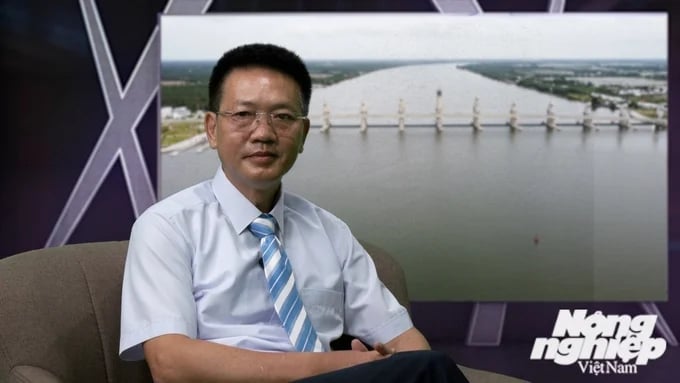November 25, 2025 | 08:55 GMT +7
November 25, 2025 | 08:55 GMT +7
Hotline: 0913.378.918
November 25, 2025 | 08:55 GMT +7
Hotline: 0913.378.918

Associate Professor, Dr Nguyen Phu Quynh, Deputy Director of the Southern Institute of Water Resources Research affirms that the Cai Lon - Cai Be sewer system has been successful in controlling salinity. Photo: Ho Thao.
The Cai Lon - Cai Be sewer project (located in An Bien and Chau Thanh districts, Kien Giang province) is considered a "super" project with a total investment of more than VND 3,300 billion. The project has received many mixed reviews, especially from experts and scientists. However, after a period of receiving criticism and contributions from specialized agencies, considering the pros and cons, the Ministry of Agriculture and Rural Development approved investment in the construction of the above project.'
Nearly 2 years after the date of operation, experts have given some assessments on the effectiveness of the project in a Talkshow conducted by Vietnam Agriculture News. The Talkshow has the topic of "Effectively operate the Cai Lon - Cai Be irrigation system".
According to Associate Professor, Dr. Nguyen Phu Quynh, Deputy Director of the Southern Institute of Water Resources Research, the Cai Lon - Cai Be irrigation system has 3 main tasks. The first task is to regulate water sources and control salinity to ensure stability in rice production and aquaculture for more than 384,000 ha of agricultural land. The second task is to contribute to the prevention and mitigation of natural disasters. The third task is to adapt to climate change to help prevent land subsidence.
Also according to Associate Professor, Dr Nguyen Phu Quynh, over the past year, the weather has been relatively favourable and the drought and salinity have not changed much. As a consequence, the second mission has not been achieved. As for the third task related to adaptation to climate change and land subsidence, it takes time to evaluate its effectiveness.

Operation of Cai Lon - Cai Be sluice brings much efficiency to the agricultural production of the Kien Giang people. Photo: D.T.Chanh.
Deputy Director of the Southern Institute of Water Resources Research affirmed: The Cai Lon - Cai Be sewer system has been successful in controlling salinity, ensuring efficiency and quality in agricultural production, contributing to local economic development and increasing income for farmers. In addition, the sewer irrigation system not only helps save costs on temporary dam construction and does not pollute water sources, but also benefits traffic.
Associate Professor, Dr. Nguyen Phu Quynh, Deputy Director of the Southern Institute of Water Resources Research noted: It is necessary to plan the road and irrigation system to ensure mechanization and reduce transportation costs. At the same time, it is necessary to coordinate the operation of the Cai Lon - Cai Be sewer between localities and levels to ensure the system operates optimally.
According to Mr Le Huu Toan, Deputy Director of the Department of Agriculture and Rural Development of Kien Giang province, after nearly 2 years of operating the Cai Lon - Cai Be sluice gate, the sluice brings many positive effects on agricultural production. Specifically, in terms of eco-tourism development, conversion from rice farming to aquaculture and infrastructure have also been upgraded.
To optimize water source control of the Cai Lon - Cai Be sewer system, it is necessary to improve the infrastructure. Currently, there are 11 sewer projects that need to be invested in to operate synchronously with the Cai Lon - Cai Be sewer cluster. Kien Giang province has asked for central capital and proposed investment in other projects.

Mr. Nguyen Huu Toan, Deputy Director of the Department of Agriculture and Rural Development of Kien Giang province participated in the Talk show organized by Vietnam Agriculture News at N3 Studio. Photo: Ho Thao.
Mr. Toan emphasized that propaganda will help people understand the main goal of the Cai Lon - Cai Be project is to control salty and sweet water. The project goals are to stabilize production models and develop livelihoods, not prevent salinity. Accordingly, propaganda also focuses on properly implementing the seasonal calendar and organizing effective seasonal production.
Deputy Director of the Department of Agriculture and Rural Development of Kien Giang province hopes that the people of Kien Giang province and neighbouring provinces will follow the production plan to take full advantage of the benefits that the Cai Lon - Cai Be irrigation system brings about.
Translated by Hoang Duy

(VAN) Viet Nam is entering the pivotal period of 2025-2030, moving toward the formulation of the Remote Sensing Law, which will establish a legal foundation for the development of national digital data.

(VAN) The agricultural sector is finalizing the strategic framework for emission reduction, setting the goal of sharply cutting methane and 403.7 million tons of CO2 equivalent and moving toward Net Zero by 2050.
/2025/11/22/2236-1-153832_483.jpg)
(VAN) The National Marine Spatial Planning is opening up opportunities for sustainable blue sea development across 21 coastal localities.

(VAN) Viet Nam’s forestry sector is undergoing a comprehensive transformation, strengthening management, protection, and development efforts to maintain ecological security and drive green, sustainable growth.

(VAN) Viet Nam is accelerating efforts to digitize reservoir operations, from real-time data to hydraulic modelling.
/2025/11/21/3348-2-102623_454.jpg)
(VAN) National Assembly delegate Nguyen Thi Lan has proposed adding special mechanisms to attract human resources to the agricultural, forestry, and fishery sectors, addressing the shortage of high-quality personnel.

(VAN) Over the past two decades, the unified legal framework for water resource management has been perfected, becoming a crucial foundation for ensuring national water security.